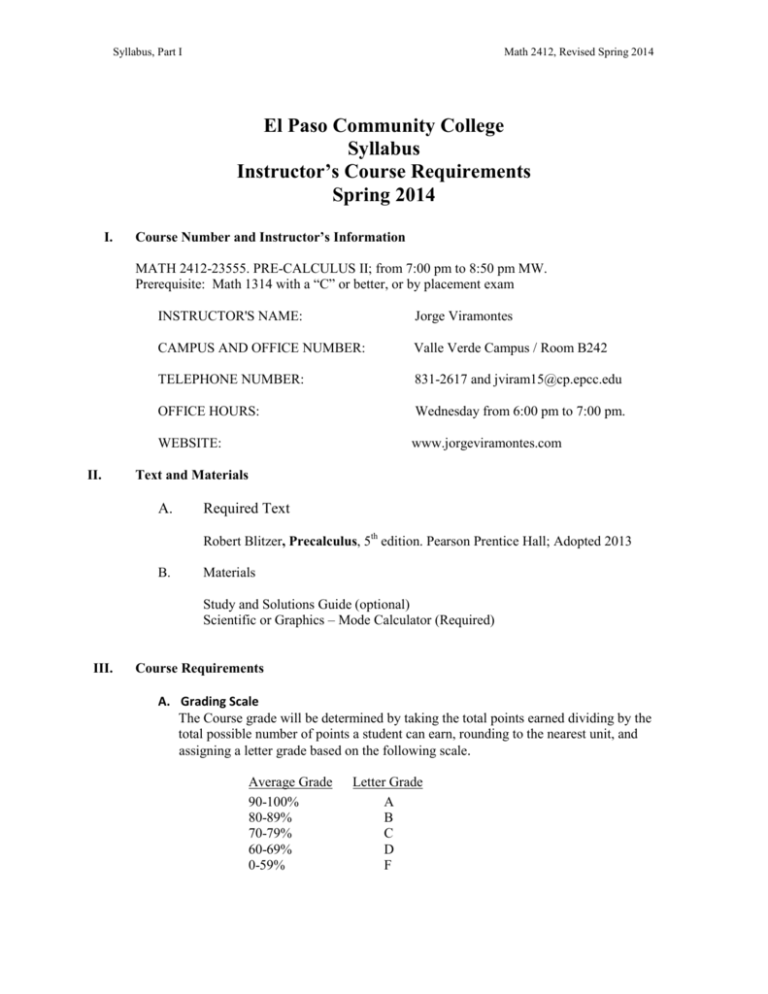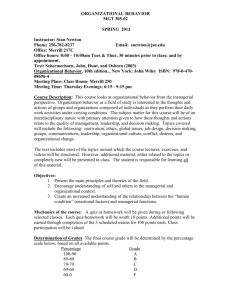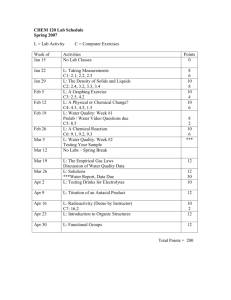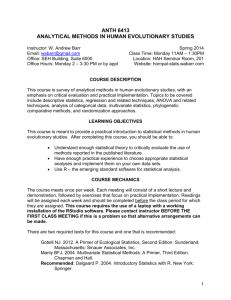
Syllabus, Part I
Math 2412, Revised Spring 2014
El Paso Community College
Syllabus
Instructor’s Course Requirements
Spring 2014
I.
Course Number and Instructor’s Information
MATH 2412-23555. PRE-CALCULUS II; from 7:00 pm to 8:50 pm MW.
Prerequisite: Math 1314 with a “C” or better, or by placement exam
II.
INSTRUCTOR'S NAME:
Jorge Viramontes
CAMPUS AND OFFICE NUMBER:
Valle Verde Campus / Room B242
TELEPHONE NUMBER:
831-2617 and jviram15@cp.epcc.edu
OFFICE HOURS:
Wednesday from 6:00 pm to 7:00 pm.
WEBSITE:
www.jorgeviramontes.com
Text and Materials
A.
Required Text
Robert Blitzer, Precalculus, 5th edition. Pearson Prentice Hall; Adopted 2013
B.
Materials
Study and Solutions Guide (optional)
Scientific or Graphics – Mode Calculator (Required)
III.
Course Requirements
A. Grading Scale
The Course grade will be determined by taking the total points earned dividing by the
total possible number of points a student can earn, rounding to the nearest unit, and
assigning a letter grade based on the following scale.
Average Grade
90-100%
80-89%
70-79%
60-69%
0-59%
Letter Grade
A
B
C
D
F
Syllabus, Part I
Math 2412, Revised Spring 2014
B. Exams: There will be three exams (see calendar below for approximate timetable)
and one comprehensive final exam. The three exams give you 50% (16.67% each) of
your final grade. The final exam gives you 20% of your final grade; and it is
comprehensive and required. There will be no retakes on exams.
It is to the student’s advantage, that the lowest exam grade or exam missed may be
replaced by the grade on the final exam.
C. Quizzes: There will be several quizzes during the course. The quizzes give you 15%
of your final grade. There will be no retakes on quizzes, and no quiz grade will be
dropped. There will be no makeup quizzes.
D. There is a Math Lab associated with this class. Your Lab grade will be weighted the
same as one exam (15%). Laboratory session is mandatory.
E. This course may be taken for Honor’s Credit, see your instructor for more
information.
IV.
Instructor’s Policies
A. Cheating
High ethical standards are prerequisites for successful careers and reflect on a
person’s character. All graded work must be the student’s own work. Situations
involving cheating (giving and receiving answers on test) will be handled according
to the student code of conduct published in the EPCC Catalog (page 72) and EPCC
7.05.01.10 Student Disciplinary Procedure.
B. Attendance-Drops
Thursday, April 17, 2014 is the last day a student can withdraw with a “W”. If you
wish to withdraw from this course it is your responsibility to complete all the
necessary paperwork. The instructor assumes no responsibility for student
withdrawal from the course or the completion of student’s course work.
C. “I” Grade
I(Incomplete) grades are assigned whenever the appropriate assignments and
deadlines are met. To be eligible for an incomplete grade, a student must have at
least 80% of the course work completed with at least a 75% average.
D. Children in the Classroom and Cell Phones
Children will not be allowed in the classroom. Cell phones and pagers must
be turned off during lecture. You will be asked to leave the classroom if you
don’t comply.
Syllabus, Part I
IV.
Math 2412, Revised Spring 2014
Calendar (Approximate)
Week
Dates
Activity
1
Jan. 19 – Jan. 25
Jan. 20 Institutional
Holiday (No Class)
4.1, 4.2, 4.3, 4.4
2
Jan. 26 – Feb. 01
4.5, 4.6
3
Feb. 02 – Feb 08
4.7, 4.8, Review
4
Feb. 09 – Feb. 15
EXAM I, 5.1, 5.2
5
Feb. 16 – Feb. 22
5.3, 5.4, 5.5
6
Feb. 23 – Mar. 01
6.1, 6.2, 6.6
7
Mar. 02 – Mar. 09
6.7, 6.5, Review
Mar. 10 – Mar. 16
Spring Break
8
Mar. 17 – Mar. 22
EXAM II, 10.1, 10.2
9
Mar. 23 – Mar. 29
10.3, 10.4
10
Mar. 30 – Apr. 5
Mar. 31Institutional
Holiday (No Classes)
10.5, 10.6, 10.7
11
Apr. 06 – Apr. 12
9.3, 9.1
12
9.2, 9.4
13
Apr. 13 – Apr. 19
Apr. 17 Last Day to
DROP with a “W”
Apr. 18 Institutional
Holiday (No Classes)
Apr. 20 – Apr. 26
14
Apr. 27 – May 03
6.4, Review
15
May 04 – May 10
16
May 11 – May 17
FINALS WEEK
Exam III, Review
final Exam
Final Exam
9.5, 6.3
Section Titles
4.1-Angles and Radian Measure
4.2-Trigonometric Functions: The Unit Circle
4.3-Right Triangle Trigonometry
4.4-Trigonometric Functions of Any Angle
4.5-Graphs of Sine and Cosine Functions
4.6-Graphs of Other Trigonometric Functions
4.7-Inverse Trigonometric Functions
4.8-Applications of Trigonometric Functions
5.1-Verifying Trigonometric Identities
5.2-Sum and Difference Formulas
5.3-Double-Angle, Power- Reducing, and
Half-Angle Formulas
5.4-Product-to-Sum and Sum-to-Product
Formulas
5.5-Trigonometric Equations
6.1-Law of Sines
6.2-Law of Cosines
6.6-Vectors
6.7-The Dot Products
6.5-Complex Numbers in Polar
Form: De Moivre’s Theorem
Spring Break
10.1-Sequences and Summation Notation
10.2-Arithmetic Sequences
10.3-Geometric Sequences and Series
10.4-Mathematical Induction
10.5-The Binomial Theorem
10.6-Counting Principles, Permutations, and
Combinations
10.7-Probability
9.3- The Parabola
9.1- The Ellipse
9.2- The Hyperbola
9.4-Rotation of Axes
9.5-Parametric Equations
6.3-Polar Coordinates
6.4-Graphs of Polar Equations
Date of Final Exam: Monday, May 12th from 7:30 pm to 9:30pm
MATH 2412; Revised Fall 2013
El Paso Community College
Syllabus
Part II
Official Course Description
SUBJECT AREA
Mathematics
COURSE RUBRIC AND NUMBER
MATH 2412
COURSE TITLE
Precalculus II
COURSE CREDIT HOURS
I.
4
Credits
4 :
Lec
1
Lab
Catalog Description
Continues MATH 1314. Studies trigonometry, trigonometric form of complex numbers, vectors,
sequences, series, mathematical induction, conic sections, polar coordinates, and probability.
Prerequisite: MATH 1314 with a “C” or better or by placement exam. (4:1).
II.
Course Objectives
Upon satisfactory completion of the course, the student will be able to solve mathematical problems that
relate to:
A. Unit I - The Trigonometric Functions and Applications of Trigonometry:
1. Angles and their measurements
2. Trigonometric functions and their graphs
3. Inverse trigonometric functions
4. Right angle trigonometry
5. Law of Sines and Law of Cosines
6. Vectors
B. Unit II – Trigonometric Identities, Conditional Equations, and Application of
Trigonometry:
1. Basic identities
2. Verifying identities
3. Sum and difference identities
4. Double-angle and half-angle identities
5. Product and sum identities
6. Conditional trigonometric equations
7. Trigonometry form of complex numbers
8. Powers and roots of complex numbers
9. Polar equations (optional)
10. Parametric equations
C. Unit III – The Conic Sections:
1. Parabola
2. Ellipse and circle
3. Hyperbola
4. Rotation of axes
5. Polar equations of conics (optional)
Revised by Discipline: Fall 2012
MATH 2412; Revised Fall 2013
D. Unit IV – Series, Sequences, and Probability:
1. Sequences and series
2. Arithmetic sequences and partial sum
3. Geometric sequences and series
4. Counting and permutations
5. Combinations, labeling, and the Binomial Theorem
6. Probability
7. Mathematical Induction
III.
THECB Learning Outcomes (ACGM)
Upon successful completion of this course, students will:
1.
Demonstrate and apply knowledge of properties of functions.
2.
Recognize and apply algebraic and transcendental functions and solve related equations.
3.
Apply graphing techniques to algebraic and transcendental functions.
4.
Compute the values of trigonometric functions for key angles in all quadrants of the unit
circle measured in both degrees and radians.
5.
Prove trigonometric identities.
6.
Solve right and oblique triangles.
IV.
Evaluation
A.
B.
C.
D.
E.
F.
Four unit tests are recommended.
Quiz grades and homework grades may also be used in the evaluation if the
instructor so chooses. Refer to Instructor's Course Requirements for details.
The laboratory is required, and the average of all lab grades will be used in the
compilation of the final course grade.
A comprehensive final examination is mandatory.
A challenge exam is available. There is a $20 fee payable at the cashier’s office on any campus.
This test must be taken before the 12th day of class.
Grades will be assigned according to the following scale:
Average
Grade
90-100
A
80-89
B
70-79
C
60-69
D
0-59 or for cheating
F
Note I and W grades will be assigned whenever the appropriate assignments and deadlines have been met.
To receive an I, the students must have completed at least 80%of the course with at least a 75 average. The
proper forms must also be signed by both the student and the instructor before being submitted to the
registrar.
V.
Disability Statement (American with/Disabilities Act [ADA])
EPCC offers a variety of services to persons with documented sensory, mental, physical, or temporary
disabling conditions to promote success in classes. If you have a disability and believe you may need
services, you are encouraged to contact the Center for Students with Disabilities to discuss your needs with
a counselor. All discussions and documentation are kept confidential. Offices located: VV Rm C-112
(831-2426); TM Rm 1400 (831-5808); RG Rm B-201 (831-4198); NWC Rm M-54 (831-8815);
and MDP Rm A-125 (831-7024).
VI.
6 Drop Rule
Students who began attending Texas public institutions of higher education for the first time during the Fall
2007 semester or later are subject to a 6-Drop limit for all undergraduate classes. Developmental, ESL,
Dual Credit and Early College High School classes are exempt from this rule. All students should consult
with their instructor before dropping a class. Academic assistance is available. Students are encouraged to
see Counseling Services if dropping because exemptions may apply. Refer to the EPCC catalog and
website for additional information.
Revised by Discipline: Fall 2012








